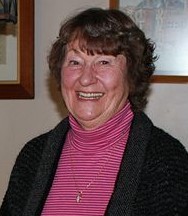Tiia Van Koldenhoven
From ABC Great Southern
By Karla Arnell
17 June, 2015
To commemorate Refugee Week, former refugees reflect on their first impressions of the country they now call home. They live in Katanning – Western Australia’s first regional Refugee Welcome Zone.
‘The first thing I remember’: a journey from Estonia to Katanning

“We were on the boat and looking down to the wharf to see if we knew anybody. “And we could spot my sister’s godfather because he was well over six foot. We called him ‘Big Bill’ because he was so tall.” Tiia Van Koldenhoven (born Ohtra) remembers arriving in Fremantle on the SS Derna in 1948. Accompanied by her mother, father and older sister, she was five years old when she began her new life in Australia.
The three month journey to the far away land was not without incident for the 545 passengers on board. “My father kept a diary of it and by the time we got to Perth, there were two people less. Either they jumped ship or what, we don’t know.
Tiia was born in Haapsalu, Estonia, 1943. It was the second year of German occupation and Soviet forces were preparing to recapture the Baltic country. Mass deportation, forced conscription and chaos marked the war years. Tiia’s father feared the worst.
“They called them the salt mines. “My father, working at a radio station as a technician, he may just as likely have been taken to Siberia,” she said. “He had to make a decision and the decision was to pack up and go.” Tiia wonders how her mother managed with a baby amidst the panic of war. “I’ve asked my sister, ‘How come my mother didn’t leave me on the roadside?’ She was old enough to walk. But they did have a little pram”.
The family caught a ferry from Estonia, but it caught on fire. A German boat picked them up and brought them ashore. Four years at an Augsburg refugee camp followed. Tiia was one of the youngest displaced people. “Because there was no one else to play with, I played with my shadow. Skipping to watch it move.” While conditions at the camp were limited and food was scarce, the sauna tradition continued. “Living in those cold countries, once a week you trooped off to the sauna and sweated it out.” All I could say was ‘yes’ or ‘no’
It was her father’s Estonian friend, Big Bill, who sponsored the family to relocate to Australia. Arriving in 1948, Tiia was required to go to school without speaking English. “They trotted me off to the North Inglewood Primary School, which was a fair distance from where we were housed and I ran home the first two days because all I could say was ‘yes’ and ‘no’. “I couldn’t understand what the teacher was trying to tell me,” she said. “So the next two days, my mother and this Estonian friend that lived in Inglewood stood outside the door and kept an eye on my escape route.”
Whilst the family spoke Estonian at home, Tiia doesn’t remember feeling different growing up. “The only thing I recall is that I was always spelling my name.”
Consulting the atlas to find Katanning
It was a teaching position that brought Tiia to Katanning in 1963. “I had to look up the atlas to find out where Katanning was. I made my way down on the bus with my big case with all my school books and whatnot.”
Tiia worked as a high school teacher, specialising in maths and science, for just on forty years. “I’ve still got students from my very first class that are in town. That’s why my husband won’t employ me to work at the [family] company, because I would intimidate the staff,” she laughs.
Tiia says the Katanning community has since gained a special insight into Baltic life. When Estonian tourists visit the region, she says they are often surprised by local’s knowledge of their home country. “They say, ‘We have a resident Estonian here'”.
Return to KATANNING WOMEN Page
Return to HOME Page
